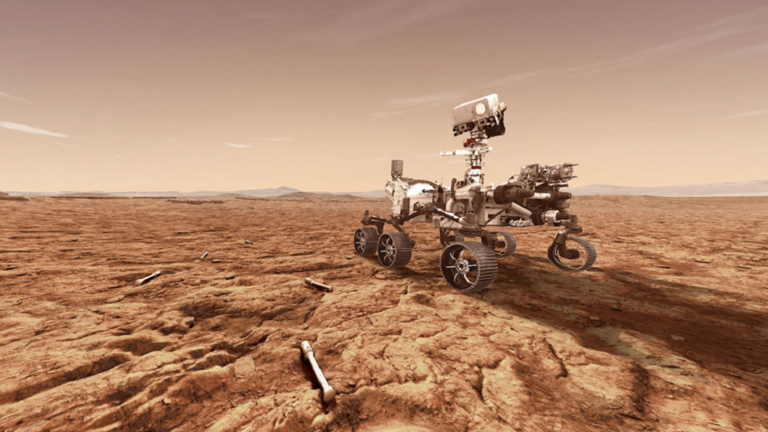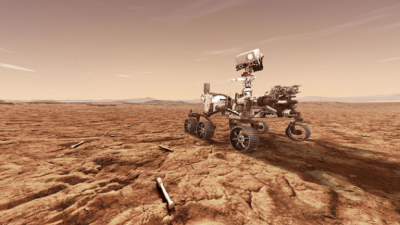NASA's "Perseverance" has finally deposited its first sample of Mars rocks for return to Earth. The rover began its mission to find ancient biosignatures in clay on the Red Planet on April 22, which could indicate the presence of extraterrestrial life. The vehicle has been exploring a delta searching for sampling sites that may contain ancient organic microbes before drilling to extract the sample.
The titanium tube contains a core of volcanic rock extracted from a region of Jezero Crater on Mars called "South Séítah" on January 31. The sample has informally been named "Malay," and it is a duplicate of one of the 17 samples currently stored in the core of "Perseverance." "Malay" was dropped in the delta base on December 21, at a site known as "Three Forks" - referring to the point where three route options merge into the delta. This represents the first ten duplicate samples to be deposited here over the next two months, but ideally, there will be no need for them.
The plan is for "Perseverance" to deliver its original samples to an automated lander that will arrive on Mars in the future. The lander will then use a robotic arm to place the tubes into a containment capsule of a small rocket, which will be launched to Mars orbit. There, another spacecraft will capture the containment capsule and return it to Earth, in what is known as the Mars Sample Return Campaign. However, if "Perseverance" is unable to deliver its original samples to the lander, two designated helicopters will instead collect the duplicate samples.
After "Perseverance" arrived at the Three Forks site, it took nearly an hour to complete the drop process. This was because it had to first reach its belly to capture the trays, then view it with its internal CacheCam. After that, it dropped it about three feet (89 cm) onto the Martian surface. Finally, engineers back at NASA's Jet Propulsion Laboratory (JPL) in Pasadena, California, needed to ensure that the sample had not rolled into the wheel tracks of "Perseverance." They also wanted to confirm that it did not land on one of its ends and that it was upright, but if it were on its side, the rover would be able to push it upright with its robotic arm. To conduct the inspection, they had the rover's WATSON camera — attached to its 7-foot-long (2-meter) arm — swing down to look underneath and confirm the successful drop.
Thus began the first human-made sample depot on another planet, which will be built with nine other samples over the coming weeks. Rick Welch, Deputy Project Manager for "Perseverance" at the Jet Propulsion Laboratory, stated: "Seeing our first sample on the ground is a fantastic culmination of our main mission phase, which ends on January 6. It’s a nice alignment; as we start our cache, we’re also closing out this first chapter of the mission." "Perseverance" landed on Mars on February 18 of last year, after a nearly seven-month journey through space, and conducted its first drive shortly thereafter for more than two weeks.
Until the beginning of "#Campaign 2" – the current search for signs of life in Jezero Crater – the rover spent time testing its instruments and surveying Mars' geological features. It collected eight core rock samples during its first scientific campaign and completed a record-breaking 31 days on Mars, traveling around 3 miles (5 kilometers). "Perseverance" arrived at Three Forks, the threshold of the ancient Jezero river delta, on April 13. The delta rises over 130 feet (40 meters) above the crater floor and holds many geological discoveries – potentially even evidence of microbial life on Mars billions of years ago.
Since then, this has served as a launch point for the rover's second science mission, the Delta Front Campaign. Scientists know from studying delta regions on Earth that fine-grained, clay-rich rocks in these environments are good at preserving ancient biosignatures, which are complex organic molecules generated by life preserved in the rocks for billions of years. "Perseverance" selects a sample using its suite of onboard instruments to detect whether organic molecules are present before drilling with its drill. Once extracted, core samples will be returned to Earth, where scientists can analyze them in laboratories. They will identify any organic materials present and detail their molecular structures.
These analyses could help determine whether any organic molecules found in the Martian delta rocks are biosignatures or non-biological organic materials. NASA aims to return these rocks to Earth in the 2030s. Scientists hope that in addition to providing answers about possible ancient life on the Red Planet, they will also reveal more about Mars' climate and how it has evolved.




